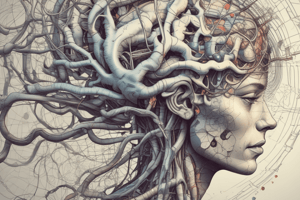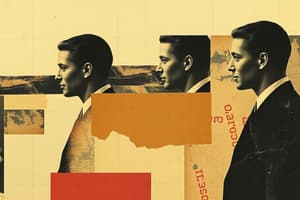Podcast
Questions and Answers
A child with cerebral palsy is exhibiting slow, writhing movements. Which type of involuntary movement is the child most likely experiencing?
A child with cerebral palsy is exhibiting slow, writhing movements. Which type of involuntary movement is the child most likely experiencing?
- Ataxia
- Spasticity
- Choreiform
- Athetoid (correct)
A physical therapist is evaluating an adult with long-standing cerebral palsy. Which of the following secondary complications is most likely to be present due to the chronic nature of their condition?
A physical therapist is evaluating an adult with long-standing cerebral palsy. Which of the following secondary complications is most likely to be present due to the chronic nature of their condition?
- Enhanced proprioception
- Disuse atrophy and potential decubitus ulcers (correct)
- Increased perception of pain, temperature, and pressure
- Improved bowel and bladder control
During a physical therapy session, a therapist notices a patient with cerebral palsy has an exaggerated anterior curvature of the lumbar spine. Which postural dysfunction is the patient exhibiting?
During a physical therapy session, a therapist notices a patient with cerebral palsy has an exaggerated anterior curvature of the lumbar spine. Which postural dysfunction is the patient exhibiting?
- Equinus deformity
- Hyperlordosis (correct)
- Hyperkyphosis
- Scoliosis
A young adult with cerebral palsy presents with a gait pattern characterized by the legs crossing inward while walking. Which of the following impairments is most likely contributing to this 'scissors gait'?
A young adult with cerebral palsy presents with a gait pattern characterized by the legs crossing inward while walking. Which of the following impairments is most likely contributing to this 'scissors gait'?
A child with cerebral palsy is being assessed for early signs of the condition. Which of the following findings would be most indicative of cerebral palsy in a toddler?
A child with cerebral palsy is being assessed for early signs of the condition. Which of the following findings would be most indicative of cerebral palsy in a toddler?
Which of the following is the most accurate description of cerebral palsy (CP)?
Which of the following is the most accurate description of cerebral palsy (CP)?
During which period is the brain most susceptible to the damage that leads to cerebral palsy?
During which period is the brain most susceptible to the damage that leads to cerebral palsy?
Which of the following is a primary cause of cerebral palsy related to oxygen deprivation?
Which of the following is a primary cause of cerebral palsy related to oxygen deprivation?
Which intrapartum event poses the greatest risk of hypoxia leading to to cerebral palsy?
Which intrapartum event poses the greatest risk of hypoxia leading to to cerebral palsy?
Postpartum, what condition is least likely to cause hypoxia or ischemia leading to cerebral palsy?
Postpartum, what condition is least likely to cause hypoxia or ischemia leading to cerebral palsy?
A difficult or prolonged delivery can lead to cerebral palsy due to:
A difficult or prolonged delivery can lead to cerebral palsy due to:
Which type of cerebral palsy is characterized by increased muscle tone, affecting approximately 75% of all cases?
Which type of cerebral palsy is characterized by increased muscle tone, affecting approximately 75% of all cases?
A child exhibits poor coordination and balance, which the doctor suspects is due to damage to the cerebellum. Which type of cerebral palsy is most likely?
A child exhibits poor coordination and balance, which the doctor suspects is due to damage to the cerebellum. Which type of cerebral palsy is most likely?
Developmental screening for motor delays in children is typically conducted at which of the following age milestones?
Developmental screening for motor delays in children is typically conducted at which of the following age milestones?
Which of the following is the primary goal of developmental and medical evaluations in the diagnosis of cerebral palsy?
Which of the following is the primary goal of developmental and medical evaluations in the diagnosis of cerebral palsy?
A child with cerebral palsy is experiencing significant muscle spasms. Which treatment is MOST likely to be prescribed to manage this symptom?
A child with cerebral palsy is experiencing significant muscle spasms. Which treatment is MOST likely to be prescribed to manage this symptom?
When providing massage to a client with cerebral palsy who has limited communication abilities, what is the MOST important initial step?
When providing massage to a client with cerebral palsy who has limited communication abilities, what is the MOST important initial step?
A massage therapist is working with a client who has scoliosis due to their cerebral palsy. Which massage outcome would be MOST indicated for this client?
A massage therapist is working with a client who has scoliosis due to their cerebral palsy. Which massage outcome would be MOST indicated for this client?
A client with cerebral palsy presents with edema in their lower limbs. Which massage outcome is MOST directly indicated?
A client with cerebral palsy presents with edema in their lower limbs. Which massage outcome is MOST directly indicated?
A client with hypertonia due to an UMN lesion is receiving massage therapy. Which massage technique would be MOST appropriate?
A client with hypertonia due to an UMN lesion is receiving massage therapy. Which massage technique would be MOST appropriate?
When working with a client who has clonus, what is the MOST important consideration for massage therapists?
When working with a client who has clonus, what is the MOST important consideration for massage therapists?
A massage therapist is treating a client with rigidity related to cerebral palsy. Which technique is MOST appropriate to address this symptom?
A massage therapist is treating a client with rigidity related to cerebral palsy. Which technique is MOST appropriate to address this symptom?
For a client with muscle weakness due to an UMN lesion, what is the BEST approach a massage therapist can take?
For a client with muscle weakness due to an UMN lesion, what is the BEST approach a massage therapist can take?
Flashcards
Cerebral Palsy (CP)
Cerebral Palsy (CP)
A group of non-progressive motor disorders caused by brain damage to an immature brain.
CP Onset Window
CP Onset Window
Brain damage occurs from the second half of pregnancy through early childhood (first 3 years).
CP Etiology
CP Etiology
Often due to lack of oxygen to the brain before, during, or after birth.
In Utero Hypoxia Causes
In Utero Hypoxia Causes
Signup and view all the flashcards
Postpartum Hypoxia Cause
Postpartum Hypoxia Cause
Signup and view all the flashcards
Traumatic CP Causes
Traumatic CP Causes
Signup and view all the flashcards
Spastic CP
Spastic CP
Signup and view all the flashcards
Athetoid CP
Athetoid CP
Signup and view all the flashcards
Early Signs of Cerebral Palsy
Early Signs of Cerebral Palsy
Signup and view all the flashcards
Athetoid Movements
Athetoid Movements
Signup and view all the flashcards
Choreiform Movements
Choreiform Movements
Signup and view all the flashcards
Ataxia
Ataxia
Signup and view all the flashcards
Postural Dysfunctions in CP
Postural Dysfunctions in CP
Signup and view all the flashcards
Developmental Monitoring
Developmental Monitoring
Signup and view all the flashcards
Developmental Screening
Developmental Screening
Signup and view all the flashcards
Developmental/Medical Evaluations
Developmental/Medical Evaluations
Signup and view all the flashcards
CP Treatment Approaches
CP Treatment Approaches
Signup and view all the flashcards
Communication with CP patients
Communication with CP patients
Signup and view all the flashcards
Comfort Considerations
Comfort Considerations
Signup and view all the flashcards
Massage for Inhalation/Rib Function
Massage for Inhalation/Rib Function
Signup and view all the flashcards
Massage for Gastrointestinal Motility
Massage for Gastrointestinal Motility
Signup and view all the flashcards
Massage for Relaxation and Comfort
Massage for Relaxation and Comfort
Signup and view all the flashcards
UMN Lesion Treatment Principles
UMN Lesion Treatment Principles
Signup and view all the flashcards
Study Notes
- Cerebral Palsy (CP) is covered
Cerebral Palsy Definition
- CP refers to a group of non-progressive, irreversible motor disorders resulting from brain damage to an immature brain.
- Brain damage can occur in utero (from the second half of pregnancy), during birth, or in early childhood (typically the first 3 years of life).
Etiology
- CP is commonly due to hypoxia.
- Possible causes include:
- Premature birth.
- Intrauterine virus (TORCH) or other infection/toxicity leading to brain damage
- Ischemic insults.
- Hypoxia or ischemia in utero or postpartum
- Trauma in utero or postpartum
Hypoxia and Ischemia
- These can occur in utero due to:
- Kink in the umbilical cord or the cord wrapping around the fetus' neck.
- Maldevelopment of the placenta.
- Shock in the mother from an accident.
- Postpartum hypoxia or ischemia may be caused by:
- Suppression of respiratory centers due to overmedication of the mother
- Pneumonia, a collapsed lung, or drowning of the infant.
Trauma
- Trauma can lead to the rupture of cerebral blood vessels.
- This can occur due to:
- Separation of the placenta.
- Difficult or prolonged delivery.
- Postpartum head injury from an accident or abuse.
- Premature babies are highly susceptible to hemorrhage.
- Strokes can occur as a result of dehydration.
Presentation
- CP presents with a wide spectrum of symptoms, ranging from mild to profound disability.
- Mild cases may only be noticeable by healthcare professionals.
Main Types of Cerebral Palsy
- Spastic: Characterized by increased tone, accounting for ~75% of cases.
- Monoplegia: Affects one limb (arm or leg).
- Diplegia: Typically affects both legs, common in spastic form, results in a scissor gait.
- Hemiplegia: Affects one side of the body, is often ambulatory.
- Quadriplegia: Affects all four limbs.
- Athetoid: Involves uncontrolled, slow, writhing movements that increase with intention and stop with sleep; individuals have difficulty holding themselves upright.
- Ataxic: Characterized by poor coordination, is the least common type, results from damage to the cerebellum.
- Mixed: Commonly a combination of spastic and athetoid types.
Symptoms
- Symptoms are often not noticeable in early infancy and become more obvious as the nervous system matures.
- Early signs may include:
- Delayed milestones.
- Persistence of primitive reflexes.
- Toddlers not walking or forming sentences.
- Other symptoms:
- Spasticity.
- Athetoid movements (slow and writhing).
- Choreiform movements (quick, uncontrolled, and without purpose that do not stop with sleep).
- Ataxia (lack of coordination and clumsiness); facial ataxia can cause grimacing.
- Reflex movements due to unintegrated developmental reflexes.
- Flaccidity that may transition to spasticity or athetoid movement.
- Pain due to muscular, neurological, and bony changes.
- Postural dysfunctions like scoliosis, hyperlordosis, and hyperkyphosis. Scoliosis can lead to respiratory difficulties.
- Contracture formation, like equinus deformity (short Achilles), internal hip rotation, and hip flexion.
- Additional symptoms:
- Permanent skeletal changes and arthritis.
- Stenosis of the cervical spine.
- Osteoporosis.
- Epilepsy, mental development delay, and emotional disturbances.
- Compromised tissue health (disuse atrophy >60 years; edema leading to decubitus ulcers).
- Peripheral nerve compression from postural imbalances.
- Sensory losses; decreased proprioception.
- Speech difficulties.
- Hearing impairment.
- Bowel and bladder function compromised.
- Visual impairment.
- Frustration and anger
- Intellect may or may not be affected.
Classic Gait Pattern
- A "scissor gait" is observed due to adductor spasticity, resulting from spastic paralysis of the hip adductor muscles.
Diagnosis (according to CDC)
- Diagnosing CP involves:
- Developmental Monitoring: Tracking a child’s growth and development over time.
- Developmental Screening: Assessing for motor or movement delays and lacking milestones, at 9, 18, 24, or 30 months.
- Developmental and Medical Evaluations: Defining the specific type of disorder and related conditions like intellectual disability, seizures, vision, hearing, and speech problems.
Treatment
- There is no cure for CP.
- Treatments include:
- Physical and occupational therapy and speech therapy to control seizures.
- Drugs to relax muscle spasms and alleviate pain.
- Surgery to correct anatomical abnormalities or release tight muscles.
- Braces and other orthotic devices.
- Wheelchairs and rolling walkers.
- Communication aids.
Massage Considerations
- For people with CP establishing a method of communication with a carer is important as they are non-verbal/non-communicative.
- Comfort:
- Support and comfort with pillows and positioning (often in a wheelchair).
- Accommodate high amounts of salivary secretions
Massage Considerations: Systemic Outcomes
- Help with inhalation and rib function, specifically in scoliosis cases.
- Help with gastrointestinal motility.
- Promote relaxation and comfort
Massage Considerations: Musculoskeletal outcomes
- Decrease edema (in the lower limb).
- Minimizes contracture formation.
- Decrease pain.
- Promote joint health.
- Promote tissue health.
- Reduce weakness
Studying That Suits You
Use AI to generate personalized quizzes and flashcards to suit your learning preferences.




